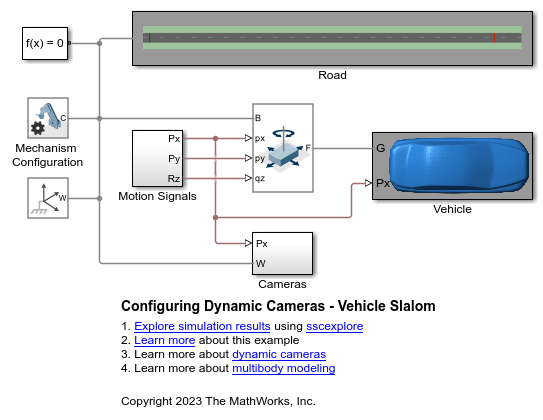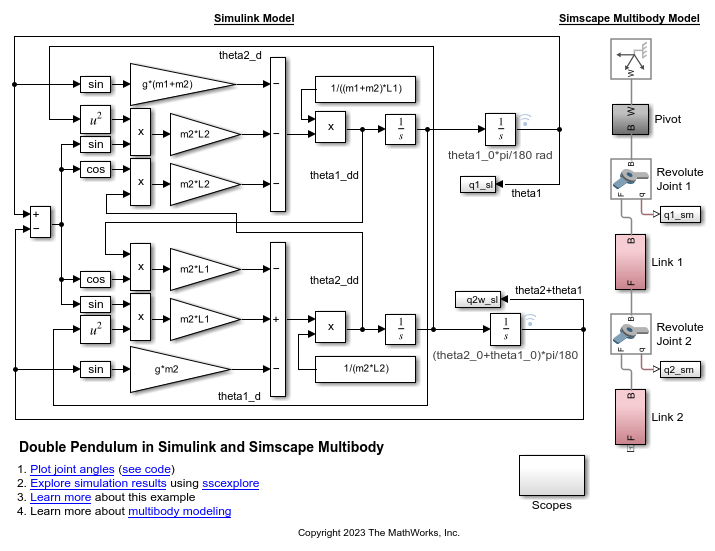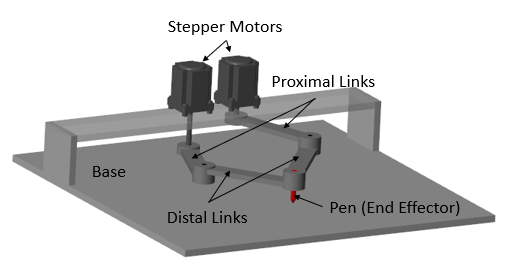Simulation and Analysis
Update the block diagram to assemble the multibody model and visualize its
initial configuration. The visualization opens in Multibody
Explorer. Simulate the model to play an interactive animation. Be
sure to pick a solver suited for physical models, such as
daessc, and to specify a maximum time step
small enough to capture the fastest meaningful change expected during
simulation.
Open Camera
Manager to add a moving, dynamic camera with which to capture the
animation. Dynamic cameras can be of two types: keyframed or tracking.
Keyframed cameras move between view points created interactively in
Multibody Explorer. Tracking cameras attach to and aim at frames in the
model. Use Video
Creator or the smwritevideo function to record
an animation in a video format.
Use the KinematicsSolver
class to create a kinematic representation of a model and formulate a
kinematic problem to solve. KinematicsSolver objects
contain all the joint variables available in a model. Complement them with
frame variables and assign both joint and frame variables as targets,
guesses, and outputs for analysis.
Tools
| Multibody Explorer | Visualize and explore multibody models |
| Camera Manager | Create, edit, and delete dynamic cameras |
| Video Creator | Create and configure videos of multibody animations |
Model Settings
Functions
Topics
Basic Visualization
- Enable Multibody Explorer
Set the model configuration parameters to ensure that Multibody Explorer opens automatically on model update or simulation. - Manipulate the Visualization Viewpoint
Select a standard view, set the up-axis convention, and use mouse shortcuts to rotate, roll, pan, or zoom a model. - Using Operating Points to Initialize Multibody Models
This example shows how to use operating points to initialize multibody models, specify the initial positions and velocities of the joints in a model, and start simulations of flexible bodies from their deformed states. - Update and Simulate a Model
Workflow steps for updating and simulating a Simscape™ Multibody™ model. - Visualize a Model and Its Components
Visualization is not only a central part of a multibody simulation, but also an essential tool in modeling bodies and verifying their shapes, sizes, frame placements, and colors. Here is an overview of the visualization utilities available in the Simscape Multibody environment and the roles they play in your modeling workflow. - Visualize Simscape Multibody Frames
Use Multibody Explorer frame highlights and Graphic blocks to visualize frames.
Advanced Visualization
- Go to a Block from Multibody Explorer
Use Multibody Explorer to go to the block corresponding to a tree view pane node. - Selective Model Visualization
Visualization filtering as a means to selectively show and hide solids, bodies, and multibody subsystems in Multibody Explorer. - Selectively Show and Hide Model Components
Use selective model visualization to show only those model components that are relevant to you.
Cameras and Video Creation
- Create a Dynamic Camera
Use Camera Manager to create or edit a model visualization camera with a moving viewpoint. - Create a Model Animation Video
Save an animation in video format using Video Creator or thesmwritevideofunction. - Visualization Cameras
Distinction between dynamic cameras and the global camera. Camera Manager as a tool for creating dynamic cameras. Dynamic camera keyframe and tracking modes. - Working with Animation
Review how model animations work and explore the basic controls available for animations.
Troubleshooting
- Multibody Simulation Issues
Learn about Simscape Multibody simulation issues.




